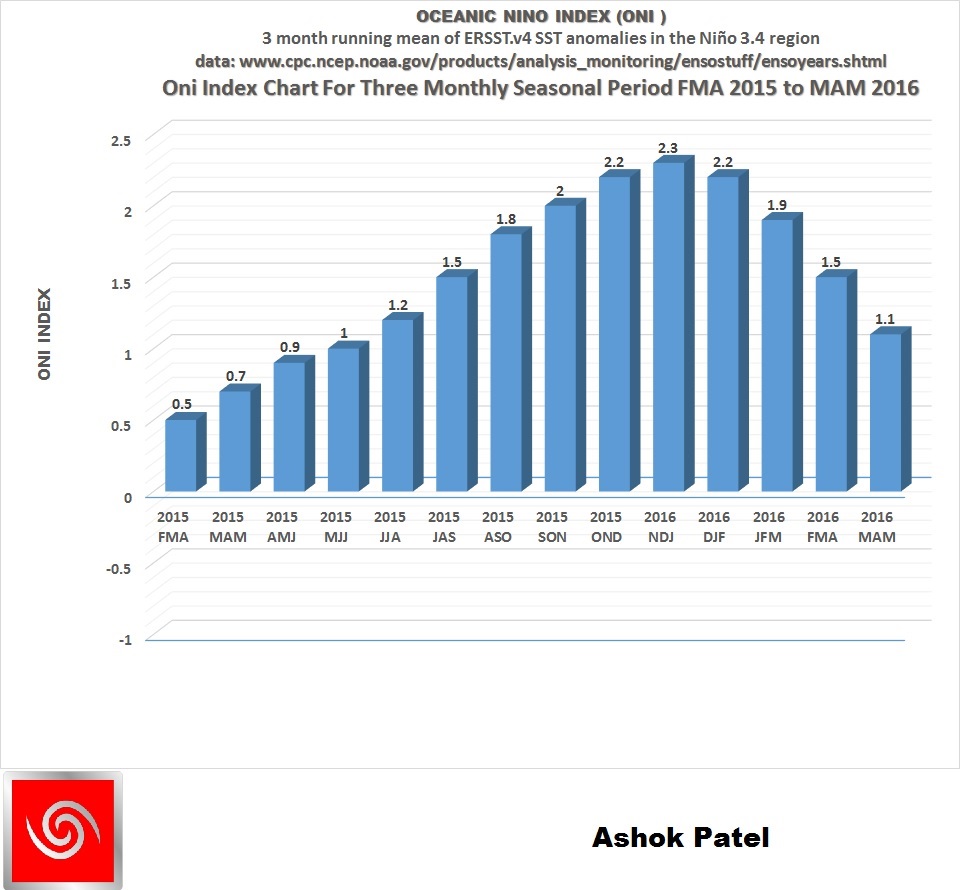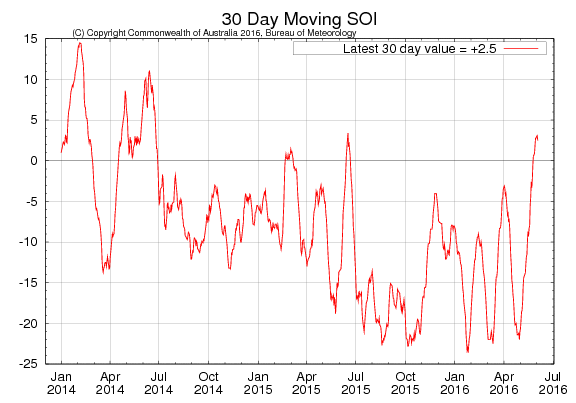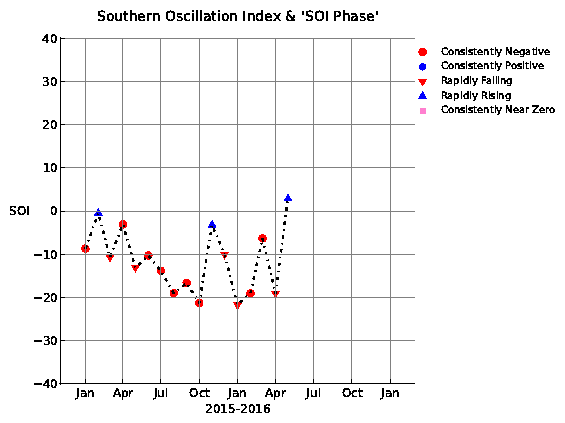El Nino Status on 5th June 2016
The ONI is based on SST departures from average in the Niño 3.4 region, and is a principal measure for monitoring, assessing, and predicting ENSO. Defined as the three-month running-mean SST departures in the Niño 3.4 region. Departures are based on a set of improved homogeneous historical SST analyses (Extended Reconstructed SST – ERSST.v4). The SST reconstruction methodology is described in Huang et al., 2015, J. Climate, vol. 28, 911-930.).
NOAA Operational Definitions for El Niño and La Niña El Niño: characterized by a positive ONI greater than or equal to +0.5ºC. La Niña: characterized by a negative ONI less than or equal to -0.5ºC. By historical standards, to be classified as a full-fledged El Niño or La Niña episode, these thresholds must be exceeded for a period of at least 5 consecutive overlapping 3-month seasons.
CPC considers El Niño or La Niña conditions to occur when the monthly Niño3.4 OISST departures meet or exceed +/- 0.5ºC along with consistent atmospheric features. These anomalies must also be forecast to persist for 3 consecutive months.
The current El Nino event was confirmed at the end of August 2015 considering the SST departures from average in the Niño 3.4 region based on Extended Reconstructed SST – (ERSST.v4). The graph below shows that currently, a moderate El Nino persists till end of May 2016, the last available 3 monthly season being MAM 2016.
Latest Oceanic Nino Index (ONI) Graph till May 2016
The Table below shows the monthly SST of Nino3.4 Region and the Climate adjusted normal SST and SST anomaly for last two years.
Period Nino3.4 ClimAdjust YR MON Temp.ºC Temp.ºC ANOM ºC 2014 5 28.02 27.96 0.06 2014 6 27.69 27.73 -0.04 2014 7 27.28 27.31 -0.02 2014 8 26.90 26.96 -0.06 2014 9 27.03 26.87 0.16 2014 10 27.25 26.83 0.42 2014 11 27.51 26.78 0.74 2014 12 27.40 26.73 0.68 2015 1 27.22 26.71 0.51 2015 2 27.25 26.89 0.36 2015 3 27.79 27.37 0.42 2015 4 28.59 27.85 0.73 2015 5 28.83 27.96 0.87 2015 6 28.70 27.73 0.97 2015 7 28.50 27.31 1.20 2015 8 28.47 26.96 1.51 2015 9 28.62 26.87 1.75 2015 10 28.86 26.83 2.03 2015 11 29.14 26.78 2.36 2015 12 29.04 26.73 2.31 2016 1 28.94 26.71 2.23 2016 2 28.89 26.89 2.01 2016 3 28.87 27.37 1.50 2016 4 28.97 27.85 1.11 2016 5 28.61 27.96 0.64
March, April & May 2016 SST anomaly for Nino3.4 region is used to calculate the latest ONI Index for MAM 2016 as +1.1ºC. Since the latest ONI Index is yet above +1.0ºC, the El Nino is classified as a Moderate El Nino till end of May 2016. The SST anomaly for May 2016 was +0.64ºC and so the El Nino is expected to weaken further.
CPC considers El Niño or La Niña conditions to occur when the monthly Niño3.4 OISST departures meet or exceed +/- 0.5°C along with consistent atmospheric features. These anomalies must also be forecast to persist for 3 consecutive months.
Southern Oscillation Index
As per BOM, Australia: The Southern Oscillation Index (SOI) has increased to +2.8 at the end of May 2016 entering the positive zone. The latest 30-day SOI value to 3rd June 2016 is +2.5 .
Sustained positive values of the SOI above +7 may indicate La Niña, while sustained negative values below −7 may indicate El Niño. Values of between about +7 and −7 generally indicate neutral conditions.
SOI Monthly graph till end of May 2016 was +3.22 as per The Long Paddock – Queensland Government.
Summary by: Climate Prediction Center / NCEP Dated 30 May 2016
ENSO Alert System Status: El Niño Advisory/ La Niña Watch El Niño is weakening.* Positive equatorial sea surface temperature (SST) anomalies are diminishing across the equatorial Pacific Ocean. La Niña is favored to develop during the Northern Hemisphere summer 2016, with about a 75% chance of La Niña during the fall and winter 2016- 17.*
* Note: These statements are updated once a month (2nd Thursday of each month) in association with the ENSO Diagnostics Discussion, which can be found by clicking here
As per BOM -Australia 24th May 2016: El Niño ends as tropical Pacific Ocean returns to neutral
The tropical Pacific Ocean has returned to a neutral El Niño–Southern Oscillation (ENSO) state. Sea surface temperatures across the tropical Pacific have cooled to neutral levels over the past fortnight, supported by much cooler-than-average waters beneath the surface. In the atmosphere, indicators such as the trade winds, cloudiness near the Date Line, and the Southern Oscillation Index have also returned to neutral levels. Outlooks suggest little chance of returning to El Niño levels, in which case mid-May will mark the end of the 2015–16 El Niño.
All earlier updates are listed below:
Click here for Update “Strong El Nino Persists Till April 2016”
Click here for Update “NOAA ERSST.v4 & ERSST.v3b & Effects On ENSO Events”
Click here for Update “Yet A Weak El Nino – 6th June 2105”
Click here for Update “El Nino Update – 5th May 2015”
Click here for Update “Weak El Nino Develops March 2015”
Click here for Update “El Nino Status – 6th March 2015”
Click here for Update “El Nino Status – 7th February 2015
”
Click here for Update “El Nino Status – 6th January 2015”
Click here for Update “El Nino Status 6th November 2014”



Sir El nino natural condition ma che to have monsoon ma kai fer far thase ke su.
No